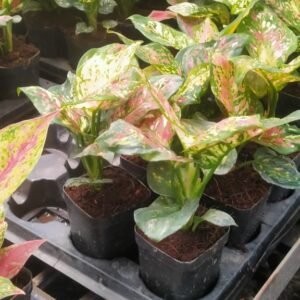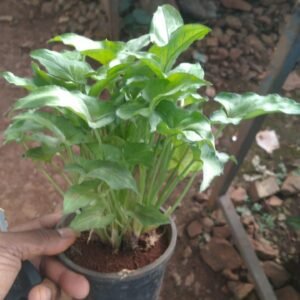Syngonium, often called the arrowhead plant or nephthytis, is a popular and versatile genus of tropical plants belonging to the family Araceae. Known for their stunning foliage and ease of care, Syngonium plants have become a favorite among houseplant enthusiasts. Let’s dive into the characteristics, care tips, and allure of this charming plant.
Overview of Syngonium
Syngonium plants are native to Central and South America, where they thrive in humid, tropical conditions. They are characterized by their distinctive arrow-shaped leaves, which often have a lush green color but can also exhibit beautiful variegation in shades of white, pink, or cream, depending on the variety. As the plant matures, the leaves can change from a single lobe to multiple lobes, which adds to their unique charm.
Some popular varieties of Syngonium include:
- Syngonium podophyllum: This species is the most common and features heart-shaped leaves with striking variegation.
- Syngonium ‘Neon’: Known for its bright, almost fluorescent green leaves, this variety adds a vibrant touch to any plant collection.
- Syngonium ‘Red Spot’: This variety boasts dark green leaves speckled with red or pink spots, making it a standout choice for collectors.
Care and Maintenance
Caring for Syngonium is relatively simple, making it a great choice for both novice and experienced plant parents. Here are some essential care tips:
Light Requirements
Syngonium plants prefer bright, indirect light. While they can tolerate low light conditions, adequate light is crucial for maintaining their vibrant leaf colors and overall health. Avoid placing them in direct sunlight, as this can scorch their leaves.
Watering
These plants like to stay moist but not soggy. Water your Syngonium when the top inch of soil feels dry. Be cautious of overwatering, as this can lead to root rot. Ensure your pot has good drainage to prevent water from accumulating at the bottom.
Humidity
Syngonium thrives in higher humidity levels, ideally between 50% and 70%. If you live in a dry climate, consider using a humidifier or placing a pebble tray filled with water beneath the plant pot. Regular misting can also help maintain humidity, especially during the winter months.
Soil
A well-draining potting mix is essential for Syngonium. A standard indoor potting soil combined with perlite or orchid bark works well, providing the necessary drainage and aeration for healthy root growth.
Propagation
Propagating Syngonium is a fun and straightforward process that can be done through stem cuttings. To propagate, take a healthy cutting below a node (the point where the leaf attaches to the stem) and place it in water or moist soil. If using water, change it regularly to keep it fresh. After a few weeks, roots should develop, allowing you to pot your new plant.
Potential Issues
While Syngonium is generally resilient, it can be susceptible to common pests like mealybugs, spider mites, and aphids. Regularly inspect your plant and wipe down the leaves to help prevent infestations. If you notice pests, treat them promptly with insecticidal soap or neem oil.
Aesthetic Appeal
One of the most attractive features of Syngonium is its decorative potential. With their striking foliage and varied colors, Syngonium plants can enhance any interior space. They are perfect for tabletop displays, hanging baskets, or as part of a mixed arrangement with other houseplants. Their compact size makes them ideal for both small and large spaces, adding a touch of greenery without overwhelming the decor.






Reviews
There are no reviews yet.